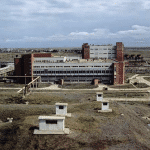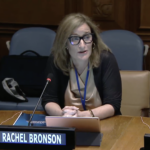Chemical weapons destruction deadline missed
By Alexander Kelle | April 24, 2012
April 29, 2012, marks the final destruction deadline for chemical weapons, according to the Chemical Weapons Convention (CWC). The United States will miss this deadline, as will the Russian Federation and Libya. This inability to comply with a crucial treaty provision that the US Senate approved and the Clinton administration ratified back in April 1997 may be puzzling to some, but it certainly should not come as a surprise.
After all, the United States — along with the other CWC states parties that declared chemical weapons possession — had already missed the first chemical weapons destruction deadline in April 2007. Plus, the anticipated time frames needed for the United States to complete chemical weapons destruction were put forth in a Government Accounting Office report published in 2000; it put the end point of destruction as far out as 2015. Then, in April 2006, after military spending priorities had led to a drastic reduction in the budgets for chemical weapons destruction facilities at Blue Grass Army Depot in Kentucky and Pueblo Chemical Depot in Colorado, then-Secretary of Defense Donald Rumsfeld acknowledged that the United States would not meet the extended 2012 deadline and instead would need until 2017 to fully destroy its chemical weapons arsenal. According to a recent conservative Defense Department assessment, the end point for completing destruction at the Pueblo facility is 2019 and completion of destruction at the Blue Grass facility is expected by 2023. This means that completion of both projects could still be up to six years past the most recent congressionally mandated deadline of December 31, 2017.
This situation left the CWC without legal guidance for destruction activities beyond April 2012, requiring the Organisation for the Prohibition of Chemical Weapons (OPCW) and its member states to find a political solution instead. Such a solution was eventually agreed upon during a meeting of the organization’s Executive Council and during the subsequent 16th session of the Conference of States Parties of the OPCW in late 2011 in The Hague, The Netherlands. The decision, “Final Extended Deadline of 29 April 2012,” however, is not as airtight as the title suggests. The agreement acknowledges that “the inability to fully meet the final extended deadline of 29 April 2012 would come about due to reasons that are unrelated to the commitment” of the United States, Russia, and Libya to fulfill this obligation. The conference decision requires the remaining possessor states to submit a detailed plan of destruction, including a planned completion date, by May 2012. It also establishes additional detailed reporting requirements for chemical weapons possessors to submit to the OPCW charting their progress toward the self-determined deadlines. This, as well as the transparency visits conducted by the Executive Council, represents the continuation of a practice that was established after chemical weapons possessor states missed the first destruction deadline in April 2007. (The organization’s departure from its usual consensus-based decision-making is noteworthy: Both the council and the conference resorted to a vote on the issue — in both of which only Iran voted against the decision. While this demonstrates Iran’s isolation on the question of how to characterize and deal with the missed chemical weapons destruction deadline, it also points to the possibility of future Iranian challenges to council and conference decisions.)
In practical terms, in order to demonstrate an ongoing commitment to and progress toward the ultimate goal of a world free of chemical weapons, it is important for CWC state parties to continue their engagement and to sustain it for as long as it takes to fully destroy chemical weapons stockpiles. While a reporting mechanism is contained in the conference decision, going beyond formal requirements with information events — such as those hosted by the American delegation to the OPCW at the margins of the past few annual conference sessions — will provide additional transparency and understanding of the technical complexities and domestic political sensitivities involved in the destruction process.
For the United States, ensuring the continuation of federal funding to the two remaining chemical weapons destruction facilities at Pueblo and Blue Grass must remain a top priority. With destruction activities completed at the nine facilities under sole control of the US Army’s Chemical Materials Agency, it is essential that the Defense Department and members of Congress continue to work together to maintain the recent high level of funding for the two facilities — Pueblo and Blue Grass — under the provenance of the Assembled Chemical Weapons Alternatives program.
On the ground, local citizens’ groups at Blue Grass and Pueblo can be expected to stay actively engaged in ensuring the safe destruction of the remaining chemical weapons stocks at the two sites. During the 16th session of the Conference of States Parties in The Hague, the participation of representatives from two US citizen groups at the Open Forum allowed local and international bodies to connect and exchange their ideas and concerns about the safe and fast destruction of chemical weapons. Ideally, such exchanges across different policy levels would not only be maintained but expanded — to include, for example, representatives from civil society groups at chemical weapons destruction facilities in Russia as well.
In sum, the remaining chemical weapons to be destroyed after April 29, 2012 — including around 10 percent of the declared US stockpile and higher percentages in Russia and Libya — will require continued international cooperation to maintain the transparency of the destruction process, national oversight to ensure that destruction activities at the remaining sites are fully funded and properly managed, and local engagement with affected communities to ensure their continued support of the destruction operations. In addition, a better understanding of policy concerns and implementation issues across these different levels will provide for a smoother path to achieving the completion of the destruction process. Complacency, by contrast, will only lead to delays, doubts, and diplomatic difficulties, which may ultimately undermine the viability of the chemical weapons prohibition regime as a whole. How this might be in any nation’s security interests — at a time when this regime has a renewed focus on preventing the reemergence of chemical weapons — is difficult to contemplate.
Together, we make the world safer.
The Bulletin elevates expert voices above the noise. But as an independent nonprofit organization, our operations depend on the support of readers like you. Help us continue to deliver quality journalism that holds leaders accountable. Your support of our work at any level is important. In return, we promise our coverage will be understandable, influential, vigilant, solution-oriented, and fair-minded. Together we can make a difference.
Topics: Biosecurity, Columnists















